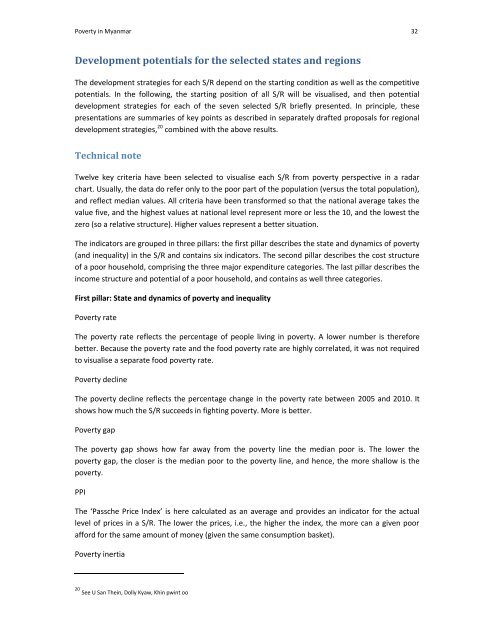A regional perspective on poverty in Myanmar - United Nations ...
A regional perspective on poverty in Myanmar - United Nations ...
A regional perspective on poverty in Myanmar - United Nations ...
Create successful ePaper yourself
Turn your PDF publications into a flip-book with our unique Google optimized e-Paper software.
Poverty <strong>in</strong> <strong>Myanmar</strong> 32<br />
Development potentials for the selected states and regi<strong>on</strong>s<br />
The development strategies for each S/R depend <strong>on</strong> the start<strong>in</strong>g c<strong>on</strong>diti<strong>on</strong> as well as the competitive<br />
potentials. In the follow<strong>in</strong>g, the start<strong>in</strong>g positi<strong>on</strong> of all S/R will be visualised, and then potential<br />
development strategies for each of the seven selected S/R briefly presented. In pr<strong>in</strong>ciple, these<br />
presentati<strong>on</strong>s are summaries of key po<strong>in</strong>ts as described <strong>in</strong> separately drafted proposals for <str<strong>on</strong>g>regi<strong>on</strong>al</str<strong>on</strong>g><br />
development strategies, 20 comb<strong>in</strong>ed with the above results.<br />
Technical note<br />
Twelve key criteria have been selected to visualise each S/R from <strong>poverty</strong> <str<strong>on</strong>g>perspective</str<strong>on</strong>g> <strong>in</strong> a radar<br />
chart. Usually, the data do refer <strong>on</strong>ly to the poor part of the populati<strong>on</strong> (versus the total populati<strong>on</strong>),<br />
and reflect median values. All criteria have been transformed so that the nati<strong>on</strong>al average takes the<br />
value five, and the highest values at nati<strong>on</strong>al level represent more or less the 10, and the lowest the<br />
zero (so a relative structure). Higher values represent a better situati<strong>on</strong>.<br />
The <strong>in</strong>dicators are grouped <strong>in</strong> three pillars: the first pillar describes the state and dynamics of <strong>poverty</strong><br />
(and <strong>in</strong>equality) <strong>in</strong> the S/R and c<strong>on</strong>ta<strong>in</strong>s six <strong>in</strong>dicators. The sec<strong>on</strong>d pillar describes the cost structure<br />
of a poor household, compris<strong>in</strong>g the three major expenditure categories. The last pillar describes the<br />
<strong>in</strong>come structure and potential of a poor household, and c<strong>on</strong>ta<strong>in</strong>s as well three categories.<br />
First pillar: State and dynamics of <strong>poverty</strong> and <strong>in</strong>equality<br />
Poverty rate<br />
The <strong>poverty</strong> rate reflects the percentage of people liv<strong>in</strong>g <strong>in</strong> <strong>poverty</strong>. A lower number is therefore<br />
better. Because the <strong>poverty</strong> rate and the food <strong>poverty</strong> rate are highly correlated, it was not required<br />
to visualise a separate food <strong>poverty</strong> rate.<br />
Poverty decl<strong>in</strong>e<br />
The <strong>poverty</strong> decl<strong>in</strong>e reflects the percentage change <strong>in</strong> the <strong>poverty</strong> rate between 2005 and 2010. It<br />
shows how much the S/R succeeds <strong>in</strong> fight<strong>in</strong>g <strong>poverty</strong>. More is better.<br />
Poverty gap<br />
The <strong>poverty</strong> gap shows how far away from the <strong>poverty</strong> l<strong>in</strong>e the median poor is. The lower the<br />
<strong>poverty</strong> gap, the closer is the median poor to the <strong>poverty</strong> l<strong>in</strong>e, and hence, the more shallow is the<br />
<strong>poverty</strong>.<br />
PPI<br />
The ‘Passche Price Index’ is here calculated as an average and provides an <strong>in</strong>dicator for the actual<br />
level of prices <strong>in</strong> a S/R. The lower the prices, i.e., the higher the <strong>in</strong>dex, the more can a given poor<br />
afford for the same amount of m<strong>on</strong>ey (given the same c<strong>on</strong>sumpti<strong>on</strong> basket).<br />
Poverty <strong>in</strong>ertia<br />
20 See U San The<strong>in</strong>, Dolly Kyaw, Kh<strong>in</strong> pw<strong>in</strong>t oo

















